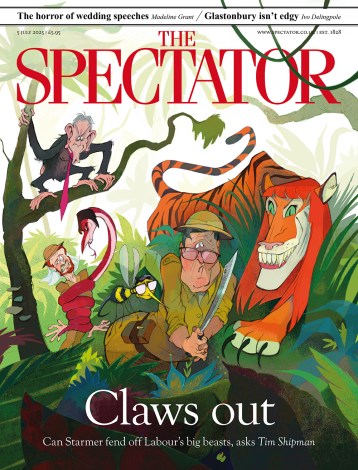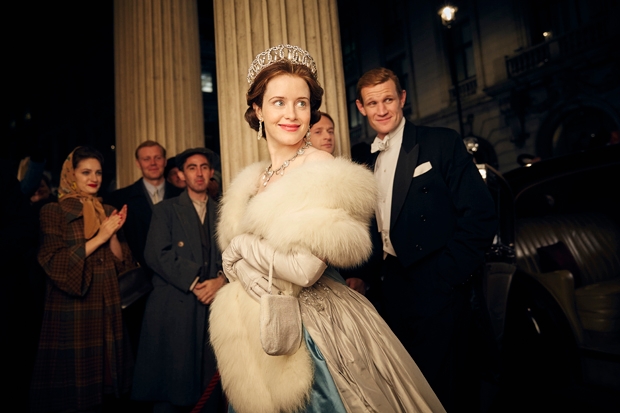Nairobi. February 1952. Laughing children brandishing sticks are driving an indignant bustle of ostriches up a rudimentary 1950s-Africa semi-bush runway towards the camera, when — WHOOSH! — right over their heads skims the exact BOAC aircraft in which the actual soon-to-be Queen Elizabeth flew to Kenya, as painstakingly rebuilt by the world’s top aircraft restorers at a cost of only $27 million…
Actually, I made up the last detail. But if you want to know why the drama departments at the BBC, Channel 4 and ITV are quaking in their boots just watch a couple of episodes of Netflix’s sumptuous, leisurely and immaculate recreation of the Queen’s early years on the throne. It’s like the moment when America entered the war: ‘Such materiel! Such manpower! Never again will we be in a position to call the shots.’
Can you believe — I still can’t — that Netflix now has a budget of $6 billion to play with? So even though The Crown may be one of the most expensive TV series ever made, its rumoured $100 million budget still counts as a drop in the ocean for the subscription channel, leaving plenty spare for a projected four more series after this ten-parter (which ends in 1965 with the death of Winston Churchill).
Sometimes, you do wonder whether The Crown is not a victim of its own superabundance and attention to detail — such as the moment in episode one where they recreate the surgical operation on George VI with such gory fidelity it would come as no surprise to learn that the actor playing the king (Jared Harris) was actually required to have a lung removed as part of the contract.
While I’m wearing my hypercritical hat, two more things irk slightly. One is that every speech made by anyone, be it stammery George VI, ingénue Elizabeth or old ham Churchill is always painfully hard won, with a nervy, tension-building pause that goes on for just that fraction too long. ‘Oh for God’s sake, just spit it out, will you?’ you find yourself thinking.
The other one is what I call the ‘unsaid word’ trick. So, for example, someone will be breaking the news that George VI has got cancer or that he’s dead. But instead of ‘cancer’ or ‘dead’, the word will be replaced by a meaningful look or a cutaway shot. This ought to work brilliantly: film is, after all, a visual medium, and scripts are much less talkie these days. The problem, once you’ve become aware of it (as unfortunately you now will be after reading this), is that instead of being moved by these scenes, and by the script’s economy and by the director’s delicacy of touch, you find yourself going: ‘Ooh, that’s right proper posh technique, that is. Real arthouse class!’
But I’m being spiteful. Mainly it’s a bloody masterpiece. Director Stephen Daldry (see what talent all that American money can buy!) has done a wonderful job recreating the stilted grimness of the early 1950s British royal court, where everyone from Queen Mary down chain-smokes, and where even a day’s pheasant-shooting comes across like a joyless duty, and of the young royals’ largely doomed attempts to flutter free of their gilded cage.

Matt Smith as Prince Philip
You feel especially sorry for and admiring of the young Prince Philip (Matt Smith), a dashing thruster still in his prime with a bright naval career ahead of him and lots of wild oats yet to sow. And now he has to give it all up because the King has died prematurely, forcing him to play the role of jumped-up escort to the most famous woman in the world.
Only the deepest love could have inspired such a fiercely independent, witty, unstuffy chap to such a sacrifice — and Smith conveys this brilliantly. I had my doubts — he was one of the more irritatingly mannered Doctor Whos — but his scenes with Claire Foy (who melts whenever they’re together and clearly idolises her glamorous Greek, because he’s so manly and capable and unfawning, at one point even using elephant-whispering skills to tame a rampaging tusker outside Treetops) are both touching and persuasive. ‘So that’s why he comes up with all those gaffes!’ you realise. ‘Because he’s so bloody frustrated.’
Peter Morgan’s script is as sensitive, intelligent and understated as you’d expect from the author of The Queen; the casting is extraordinary, from Eileen Atkins’s Queen Mary (like Miss Havisham’s grimmer grandmother) to the flighty Vanessa Kirby who looks more like Princess Margaret than even Princess Margaret did. And almost every set piece, every tiny domestic scene, is an absolute swooner, such as the one where Margaret and her very soon to be dead dad perform a heartbreaking duet of ‘Bewitched’. Subscribe to Netflix asap, I should — and give up on terrestrial TV altogether.







Comments